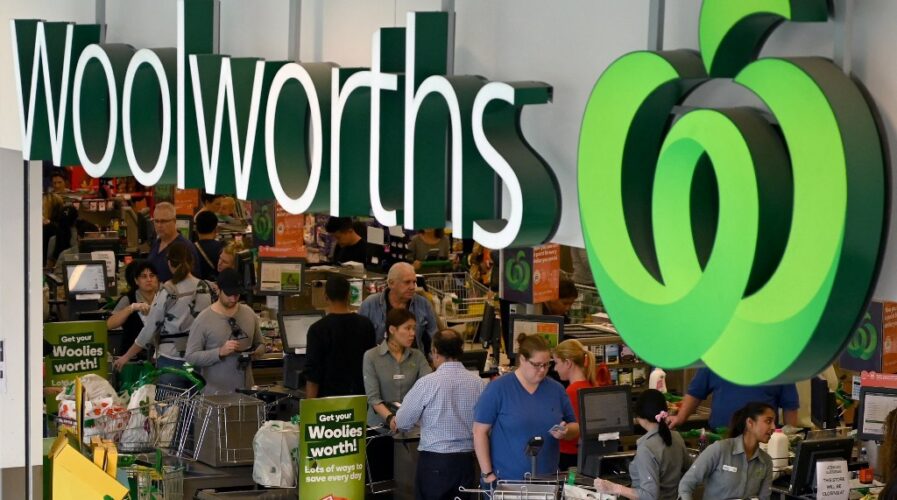
People shop at a Woolworths supermarket in Sydney. (Photo by PETER PARKS / AFP)
Woolworths Group weaves into Aussie fintech market with WPay
- WPay will support both in-store and digital payments
- Also comes with a digital wallet and analytics for merchants
- Integrates simpler gifting, loyalty, and direct marketing solutions
Woolworths Group, the parent company of global supermarket chain Woolworths, recently announced the launch of its standalone payments solution, WPay. Targeting both the New Zealand and Australian markets, WPay proffers an end-to-end payments solution for external retailers in these countries.
Woolworths Group leverages payment volume experience
According to Woolworths Group CEO Brad Banducci, the group has been looking at expanding its payment capabilities for years and is keen to extend the benefits of its investments to external merchants that lack the scale to build their own systems.
They draw on their massive national scale and capabilities in payments, being the fifth-largest processor of card payments in Australia, with over 1.3B worth of annual transactions amounting to over AUD$ 50B in value.
“Payments are an increasingly important part of the shopping experience both in-store and online and we bring unique expertise to this space as retailers.
“We’ll continue to invest in our platform to unlock the best possible experience for our stores and merchant partners”, shared Banducci.
Aside from payment solutions, merchants in the region are also looking for easier ways to integrate gifting, loyalty, and direct marketing platforms into their services, which didn’t go unnoticed by Australia’s number one e-tailer Woolworths.
WPay’s offerings for retail merchants
The payments and commerce platform WPay boasts features like:
- Integrated in-store and digital payments, supporting traditional card payments, digital wallets, and alternative payment methods, optimized for use in Australia;
- Payment services including transaction processing at scale, rapid funds settlement and simple reconciliation, fraud management, detailed reporting and merchant analytics; and
- Gift card program management including sales, redemptions, and distribution partnerships
Woolworths Group invests heavily in digital
Prior to the launch of WPay, the group has been heavily involved in various efforts, such as launching digital startup HealthyLife, targeting the health-conscious market with health and wellness advice and products, and revamped its e-commerce delivery subscription service Delivery Unlimited.
On the green tech side of things, they’ve also invested in a PPA with NSW Wind Farm as part of its plans to achieve 100% green electricity consumption by 2025, on top of facilitating battery recycling by consumers through the provision of 1,000 collection bins across its outlets.
Australia’s Fintech Evolution
According to the report KPMG Fintech Landscape 2020, Australia has 733 active fintech players. This lively ecosystem is being supported by the addition of new players in both consumer and SME-lending subsectors, as well as Buy-Now-Pay-Later service providers.
Additionally, there has been a bump in blockchain and cryptocurrency fintech providers, reflecting the general interest in these segments. Neobanking too has taken off, despite delays in the licensing process by APRA. Global advisory firm Ernst & Young in Oct 2020 expressed optimism for the Australian fintech industry to expand globally.
In the EY FinTech Australia Census 2020, it became apparent that in the maturing fintech industry, 78% of respondents saw strong growth in paying customers. The top segments fuelling this bullish sentiment include payments, wallets, supply chain, lending, and data analytics.
Covid-19 pandemic brings increased attention to digital
The Australian government is strengthening the country’s digital economy with a strong emphasis on technology, in the Australian federal budget for 2020 and 2021. The nation has seen a surge in 5G consumption during the period, although operators have been quick to roll out increased services for users, with the government declaring 2021 the ‘Year of 5G’.
E-commerce, too, has seen a massive boom in both Australia and New Zealand, effectively making these countries the largest markets in the world to see growth in the e-commerce sector last year, a far cry from their sluggish online sales pre-2020.
However, the continent’s rapid digitalization means that local firms are still struggling to deal with cybersecurity issues. In 2020, the government beefed up its cybersecurity efforts with an injection of US$63 million to deal with increased threats during the Covid-19 pandemic.
READ MORE
- Strategies for Democratizing GenAI
- The criticality of endpoint management in cybersecurity and operations
- Ethical AI: The renewed importance of safeguarding data and customer privacy in Generative AI applications
- How Japan balances AI-driven opportunities with cybersecurity needs
- Deploying SASE: Benchmarking your approach


